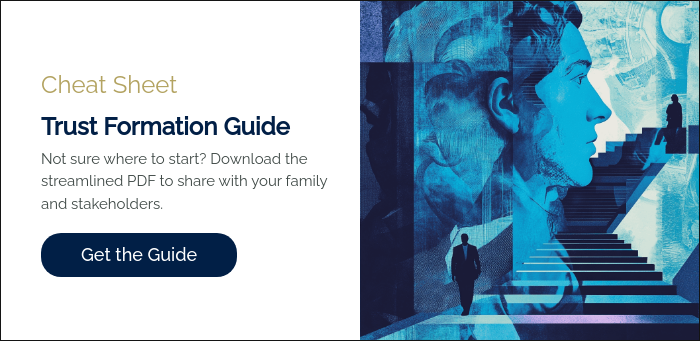The Role of Trusts in Estate Planning
Key Considerations for Family Offices
Trusts play a pivotal role in the estate planning process, especially for high net worth individuals and their families. They offer a range of benefits, including asset protection, tax efficiency, and the ability to control wealth distribution across generations. This article delves into crucial aspects of incorporating trusts into your estate plan, focusing on trustee selection, contact management, account association, and the importance of entity mapping.
Selecting the Right Trustee
Choosing an appropriate trustee is one of the most critical decisions in trust creation. The trustee is responsible for managing trust assets and carrying out the trust's terms. Consider the following when selecting a trustee:
- The trustee should have financial acumen and understand tax laws and trust administration.
- Impartiality: For family trusts, consider whether a family member can remain objective or if a professional trustee would be more appropriate.
- Longevity: For long-term trusts, consider institutional trustees that can provide continuity.
- Flexibility: Some trusts benefit from having multiple trustees or a trust protector who can remove and replace trustees.
- Communication Skills: The trustee should be able to effectively communicate with beneficiaries and other stakeholders.
- Time and Willingness: Ensure the chosen trustee has the time and desire to fulfill the role effectively.
Remember, the choice of trustee can significantly impact the trust's success in achieving your estate planning goals.
The Importance of Clean Contact Records
Maintaining accurate and up-to-date contact records is crucial for effective trust administration. Here's why:
- Efficient Communication: Trustees need to communicate regularly with beneficiaries, tax authorities, and financial institutions.
- Legal Compliance: Many jurisdictions require trustees to provide regular updates to beneficiaries.
- Smooth Transitions: In case of a change in trustee, comprehensive contact records ensure continuity.
- Disaster Recovery: In unforeseen circumstances, having backup contact information can be crucial.
- Beneficiary Updates: As families grow and change, keeping beneficiary information current is essential.
Implement a system to regularly review and update contact information for all parties involved in your trusts.
Understanding Account-Entity Associations
Clarity about which accounts are associated with which entities is vital for several reasons:
- Tax Reporting: Accurate account-entity associations ensure correct tax filings and avoid penalties.
- Asset Protection: Knowing which assets belong to which entities helps maintain the integrity of your asset protection strategy.
- Investment Management: It allows for more effective implementation of investment strategies across different entities.
- Compliance: It aids in meeting regulatory requirements, especially for complex trust structures.
- Beneficiary Rights: Clear associations help in determining beneficiary rights to specific assets or accounts.
Regularly audit your accounts and entities to ensure all associations are correctly documented and understood.
The Value of an Entity Map
An entity map is a visual representation of how various trusts, companies, and other entities in your estate plan relate to each other. Its value cannot be overstated:
- Holistic View: It provides a bird's-eye view of your entire estate structure.
- Strategic Planning: Helps in identifying opportunities for tax efficiency or structural improvements.
- Risk Assessment: Allows for easier identification of potential vulnerabilities in your estate plan.
- Succession Planning: Facilitates better planning for business succession and wealth transfer.
- Communication Tool: Serves as an excellent tool for explaining complex structures to family members or advisors.
- Compliance Aid: Helps ensure all entities are properly maintained and compliant with relevant laws.
- Decision Making: Supports informed decision-making about creating new entities or dissolving existing ones.
Regularly update your entity map as your estate plan evolves. Consider using specialized software or working with professionals to create and maintain this valuable tool.
Best Practices for Trust Integration in Estate Planning
- Regular Reviews: Schedule annual reviews of your trust structures with your estate planning team.
- Education: Ensure family members understand the purpose and function of various trusts.
- Professional Collaboration: Foster collaboration between your trustee, financial advisor, and estate planning attorney.
- Documentation: Maintain meticulous records of trust activities, decisions, and communications.
- Flexibility: Where possible, build flexibility into trust structures to adapt to changing laws and family circumstances.
- Technology Utilization: Leverage estate planning software for better organization and management of trust information.
- Succession Planning: Have a clear plan for trustee succession to ensure continuity.
Conclusion
Trusts are powerful tools in estate planning, offering numerous benefits for high net worth individuals and families. However, their effectiveness relies heavily on careful planning, meticulous record-keeping, and strategic management. By focusing on thoughtful trustee selection, maintaining clean contact records, understanding account-entity associations, and utilizing entity maps, you can maximize the benefits of trusts in your estate plan.
Remember, while these considerations are crucial, estate planning is a complex field that requires personalized advice. Always consult with qualified legal and financial professionals to ensure your trust strategy aligns with your overall estate planning goals and complies with current laws and regulations.
Copia is wealth management software that comes loaded with lenses designed specifically for family offices and institutions. Ready to track your estate plan digitally? Get started with Copia.
You May Also Like
These Related Stories

Where did capital calls come from?

Understanding Large Language Models (LLMs)


